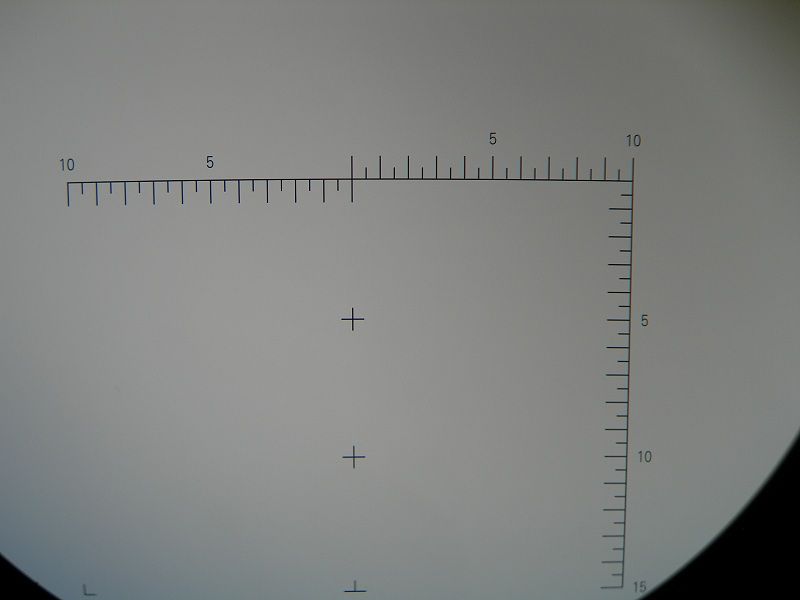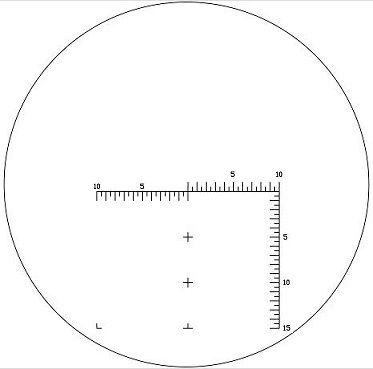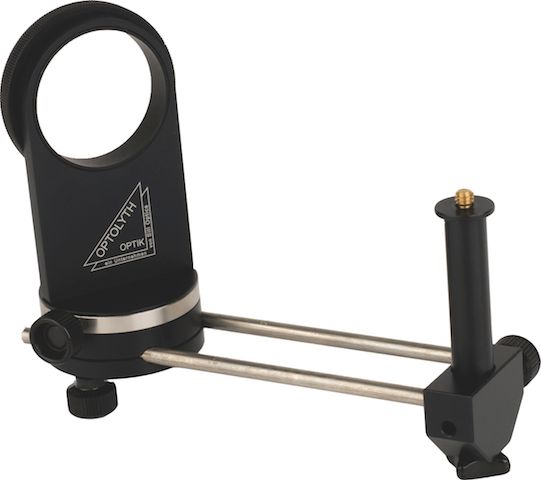Fellow Hiders -
Several years ago I bought a Zeiss Diascope 65T FL spotting scope and a Zeiss Vario Eyepiece. I also planned to buy the Zeiss Fixed Eyepiece with the #43 Mildot reticle. Unfortunately for me, Zeiss Germany stopped exporting their Fixed Mildot Eyepiece and I couldn't find a dealer who had one in stock or could get one when I was ready to buy the Eyepiece. I spent close to four years looking for a Zeiss #43 Mildot Eyepiece to no avail.
Finally giving-up on ever being able to get one of the Zeiss #43 Mildot Eyepieces and knowing that obtaining the [Fixed] MIL reticle Eyepiece Zeiss produced for the Finnish Army was nothing more than a pipedream I started looking at other MIL reticle spotter options. I wanted a compact, lightweight spotting scope with superb image quality in a 45-degree angle body like my Diascope 65T FL. I also wanted as much eye relief as possible for use with glasses, so my options were rather limited.
After lots and lots of research I decided on the HD version of the Optolyth S80 Compact . Optolyth isn't as well known in the U.S. as Zeiss, Swarovski, Leica, Leupold, or Vortex, but their optics lineup and products are excellent. In the photographic world Optolyth lenses are considered to be right (at the top) with Zeiss. I bought the Optolyth 20-60X variable Eyepiece and a 30X Wide Angle Eyepiece with rotating MIL Hash reticle. The rotating reticle is really cool, as you can orient the reticle to be "square" regardless of the orientation of the Scope's Body within it's Rotating Collar.
Optolyth Compact Ergonomics:
Optolyth Compacts feature aluminum bodies with rubber-armor, Single Focus knobs, and 360-degree Rotating Collars. The G80 is a "Straight" model and the S80 is an "Angled" model. Both are available in both HD and non-HD versions. The HD versions use Fluorite glass.
The Bodies of the Optolyth Compacts are streamlined and taper gracefully from front to rear compared to the Zeiss Diascope 65T & 85T FL Bodies, whose Focus Knob "hump" and rear end are rather abrupt and bulky. Another nice touch is that the Optolyth Compacts have a threaded ring on the Body where the Eyepiece attaches. A hard plastic Dust Cover is supplied and can be threaded on to cover and protect the Eyepiece when not in use.
The rubber armor cushions the body from knocks and bumps, and the texture of Optolyth's rubber armor is similar to the texture of the rubber armor on the Swarovski spotters and the LG30 Laser Guide. The color is bluish compared the Swarovski Forest Green.
The Single Focus Knob glides smoothly throughout the adjustment range, and "dials-in" rapidly. After getting used to the Dual (Coarse and Fine Focus) Knobs of my (previous generation) Diascope 65T FL I found that I had to tweek the Focus very slowly for the most exacting focus. The newest generation Diascopes' have single focus knobs rather than the dual focusing knobs of previous Diascopes'.
S80 HD Compact Body:
The S80 Compact's Body is about .75" longer than the Body of the Diascope 65T FL, but because Zeiss Eyepieces are longer than Optolyth Eyepieces the S80 Compact actually winds-up being about the same OAL as a Diascope 65T FL and substantially shorter than a Diascope 85T FL once Eyepieces are attached their respective spotters. My S80 HD Compact equipped with the Optolyth 20-60X variable Eyepiece weighs just under 1 lb. more than my non-rubber armored 65T FL equipped with the Zeiss Vario 15-45X/20-60X Eyepiece.
Optolyth attaches the Eyepieces to the Body securely via standard threading rather than a bayonet attachment as on the Zeiss Diascopes'.
Optolyth Eyepieces:
The 30X Wide Angle MIL Reticle Eyepiece is fun to use, providing a wide FOV and razor-sharp, bright image behind it's MIL-based reticle. Optolyth offers a 30X WA for use on the 80mm Optolyths, and a 45X WA Eyepiece for use on the 100mm Optolyths. The reticle is placed in the lower half of the view and is designed to be used with the median leveled on the object under observation. The reticle has 10 MILs' of windage each direction and 15 MILs' of Elevation. There are 1 MIL tall hashes at each MIL and half-MIL tall hashes at each .5 MIL. In addition, there are "+" Elevation indicators every 5 MILs' from the center of the reticle's "aiming point".
The really cool thing (besides being a MIL Eyepiece) is that the reticle rotates within the Eyepiece so the reticle can be oriented perfectly regardless of the position of the Scope Body's orientation within the Rotating Ring, a big plus when the scope is offaxis from you and/or the scope Body is rotated either Right or Left). The ring that rotates the reticle is rubber-covered and is just forward of the Diopter Ring.
Also, Optolyth's MIL Reticle drawing isn't drawn to scale at all. The Reticle is actually much larger than depicted in the drawing - maybe 25% larger. As a result the SW and SE "corners" are much closer to the edge than shown in the Optolyth drawing. The number "15" of the Elevation Scale is especially close to the edge.
The Optolyth 30X WA Eyepieces have noticeably longer Eye Relief than the Zeiss Vario 15-45X/20-60X Eyepiece, which makes viewing very easy. The 30X WA Eyepieces' have fold-down Rubber Eyecups, and eyeglass wearers' will need to fold-down the Eyecup for best eye relief.
The 20-60X Eyepiece has extreme clarity at both low and high power. While the clarity isn't as quite as good at full (60X) as it is at lower power it is still very good. Anyone with any experience and understanding of optics knows that the clarity of all variable magnification optics declines as the magnification increases - it is just less so with higher end optics such as Zeiss, Swarovski, Leica, Optolyth, and the Kowa's flagship 88mm Prominar.
As with the Optolyth 30X WAs', the Optolyth 20-60X has noticeably longer Eye Relief than the Zeiss Vario 15-45X/20-60X Eyepiece, making viewing very easy. The Optolyth 20-60X and 30-60X Eyepieces' have Rubber Eyecups, and eyeglass wearers' will need to leave the Eyecups folded down for best eye relief.
S80 HD Compact Optical Performance:
OK, so the Optolyth S80 HD Compact is relatively compact and lightweight (its' kind of strange to say that since the S80 Compact weighs 4 lbs., 1.8 oz. with either the Variable or Fixed Eyepieces), but what about the optical quality? How does it compare to a Zeiss? Remember that my criteria were compact size, lightweight, superb image quality, generous eye relief, and 45-degree angle body.
I needed another tripod for a side-by side comparison so I headed down to my brother's house to borrow a second tripod. Mounting my Diascope 65T FL with it's Zeiss Vario 15-45X/20-60X Eyepiece on a Manfrotto 3221 alongside my new Optolyth S80 HD Compact with Optolyth 20-60X Eyepiece on top of my Gitzo 1550T my brother and I adjusted the Eyepieces of both scopes to apparent equivalent magnifications. We then looked at the leaves and branches of nearby elm and eucalyptus trees in sunlight and shadow.
My brother and I both noted that the view through the Zeiss 65T FL was noticeably brighter than the view through the Optolyth S80 HD Compact. This extra bright view gave the 65T FL a slight - and I mean very slight, edge when peering into the shadows and in overall clarity and the ability to discern detail. The downside is that the 65T's "brightness" tends to give the image a somewhat "washed-out" look compared to the Optolyth S80 HD Compact and a Swarovski. Anyone who has looked through a Diascope alongside a Swarovski HD knows what I'm talking about.
The S80 HD Compact has markedly better color rendition - the colors are more life-like without being over-saturated. The color and contrast are so good and the view is so sharp that the image looks 3D. Its' that good. Still, while the image is razor-sharp and has excellent depth-of-field, I still have to give a slight - and I mean very slight , edge to the Diascope 65T FL for overall clarity. I attribute this to Zeiss' lens coatings, which are arguably the best in the optics world.
In low light performance, the S80 HD Compact was definitely superior. I was able to discern individual trees and bushes in the dark more easily with the S80 HD Compact than with my 65T FL. However, in my opinion (and to my 47 year-old eyes), the difference is not overwhelming. This is despite the S80 HD Compact's 15mm Objective Lens diameter advantage over the 65T FL. Chock it up to superior lens coatings' or better execution of optical design, the 65T FL held it's own against the S80 HD Compact more than an hour after sunset and in the pre-dawn hours of morning. The S80 Compact's 15mm Objective advantage only becomes more pronounced in very low light.
So, (to my brother and I) the 65T FL holds a slight edge in daylight optical performance over the larger, heavier S80 HD Compact, while the tables are turned after dark. Is it worth carrying around an extra pound of scope in your pack just for the slightly better low light performance? Not to me.
If your main criteria is image quality and you don't care about a MIL reticle I would probably choose a Zeiss Diascope 65T FL or the bigger Zeiss Diascope 85T FL as they are probably going to provide brighter images than the current Optolyth HD Compacts'. However, as the Zeiss Mildot Eyepieces are harder to find than hen's teeth these days, if you want a MIL reticle Eyepiece the Optolyth S80 HD is the better bet as the optical performance is very close to the Zeiss 65T FL and a 30X MIL Eyepiece is readily available. And once you've used it, you realize that the rotating reticle of the Optolyth MIL Eyepiece is a must-have feature on an Eyepiece that is used on a spotting scope with a rotating collar.
When the 30X Wide Angle Fixed Eyepiece is attached, or when the 20-60X Eyepiece is attached and turned-down to "low" magnification (<30X), there is a very faint grayish halo around the outer edge of the view. I'm not sure what it is, but its' as if the gray anodized barrel (which extends more than an inch forward of the Objective Lens) is just within the "corner" of the extreme edges of the view. It doesn't seem to be vignetting, as the image at the edge is still bright, colorful, and sharp. You have to look for it. Not a deal-breaker, but I know its' there.
Also, my S80 HD Compact has a slight yellowish cast to the image. Naturally-occurring Fluorite crystals come in all colors of the spectrum (the colors are caused by impurities in the crystal). Therefore, color casts are "normal" with Fluorite glass. However, Pure Fluorite, such as is used in the Kowa Prominar 883 and 884 is colorless. This is probably one of the primary factors in the 88mm Prominar's wonderful resolution and color fidelity.
I really like my new Optolyth S80 HD Compact, but have four (4) gripes about it:
(1) See "NOTES": above. While a bit annoying I don't "focus" on it, and I don't regret buying my S80 HD Compact or selling my Diascope 65T FL. Like most scopes, the 65T FL had a slight loss of "flatness" and clarity at the extreme edge of the view. I didn't sell my 65T FL until I had evaluated the two scopes side-by-side, and based on that comparision I highly recommend the S80 HD Compact - especially if you want the option of a MIL-based Eyepiece. And remember, only Optolyth offers a MIL Reticle Eyepiece that rotates to keep the reticle square to the horizon.
(2) The barrel isn't threaded to accept a filter. This prevents me from using a Hoya SMC UV Haze Filter to protect the Objective lens. Nothing I can do about this so I have to drive-on.
(3) The Pivot Tension Knob on the Rotating Collar is rather tall, and it's shaft is too long. As a result the Pivot Tension Knob sticks-out conspicuously, ready to snag on anything that gets too close. If I can't easily find a lower profile knob to replace the factory knob I'll probably just shorten the shaft on the factory knob so it doesn't stick-out so damn far.
(4) Both of my Eyepieces were missing one protective cap each as they came from the factory. The 20-60X Eyepiece was missing the cap that fits over the Ocular end, and the 30X Wide Angle MIL Reticle Eyepiece was missing the protective cap that fits over the Objective end. The factory may have figured that the Eyepiece will be threaded into the Body and the Eyepiece Cover will be used to protect the Eyepiece when the scope isn't in use, but what if the Eyepiece(s) aren't on the Body or you have multiple Eyepieces?
Great scope and eyepieces, but Optolyth shorts you on a couple of .02 cent caps that protect the lenses of $500.00 Eyepieces. WTF? I measured the O.D.s' of both ends of both Eyepieces and will be buying some quality push-on lens caps to protect the Eyepiece lenses when off the Body. Annoying, as good German-made lens caps run $10.00 or more depending on the size.
I've contacted a couple of Hide Vendors and plan on having one of them sew me a padded, custom SOC (Stay-On-Case) and couple of padded Eyepiece Cases so they don't get bashed around too much in my drag bag or other packs. The availability and production schedule of those Vendors is key in who will be my choice.
Zeiss Diascope 65T FL Body (left) compared to Optolyth S80 HD Compact Body (right):
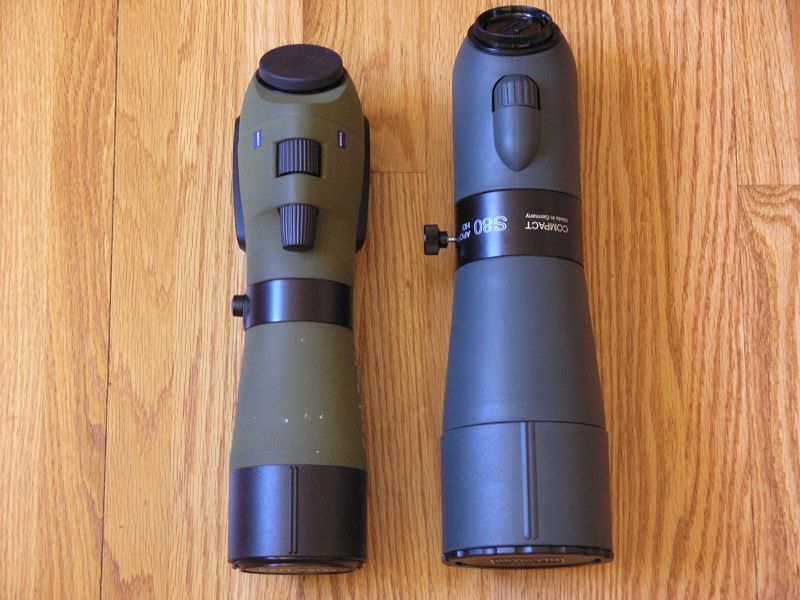
Zeiss Diascope 65T FL & Zeiss Vario 15-45X/20-60X Eyepiece (left) compared to Optolyth S80 HD Compact & Optolyth 20-60X Eyepiece (right):
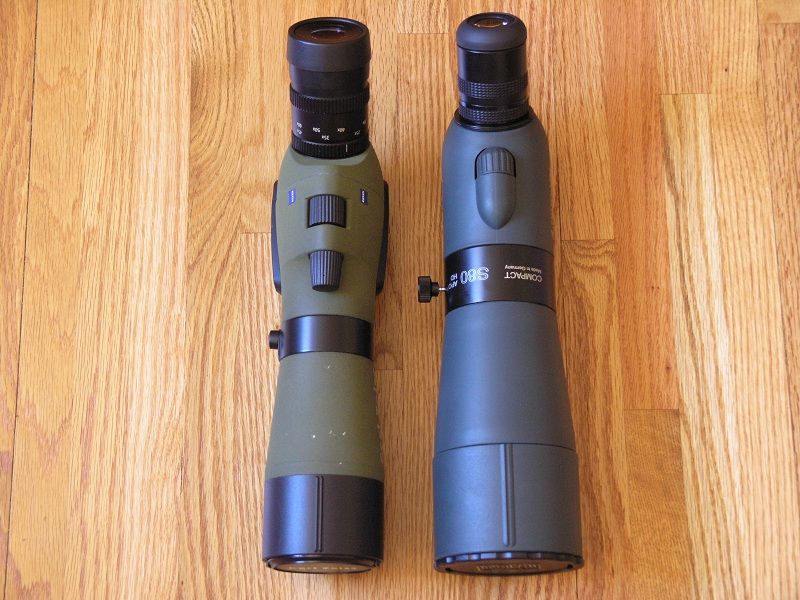
Zeiss Diascope 65T FL & Zeiss Vario 15-45X/20-60X Eyepiece (back) compared to Optolyth S80 HD Compact & Optolyth 20-60X Eyepiece (front):

Zeiss Diascope 65T FL & Zeiss Vario 15-45X/20-60X Eyepiece (top) compared to Optolyth S80 HD Compact & Optolyth 20-60X Eyepiece (bottom):
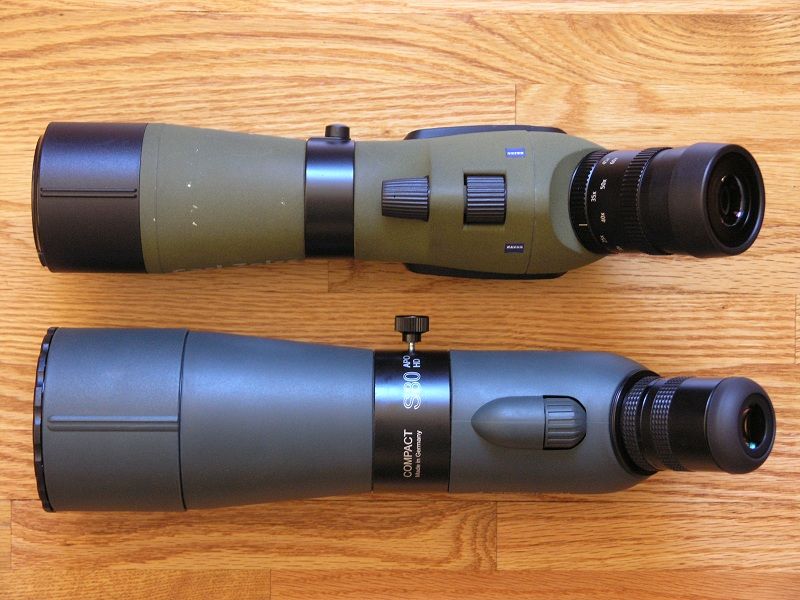
Optolyth 30X Wide Angle (Left), Zeiss Vario Zoom Eyepiece (Center), and Optolyth 20-60X Zoom Eyepiece (Right):
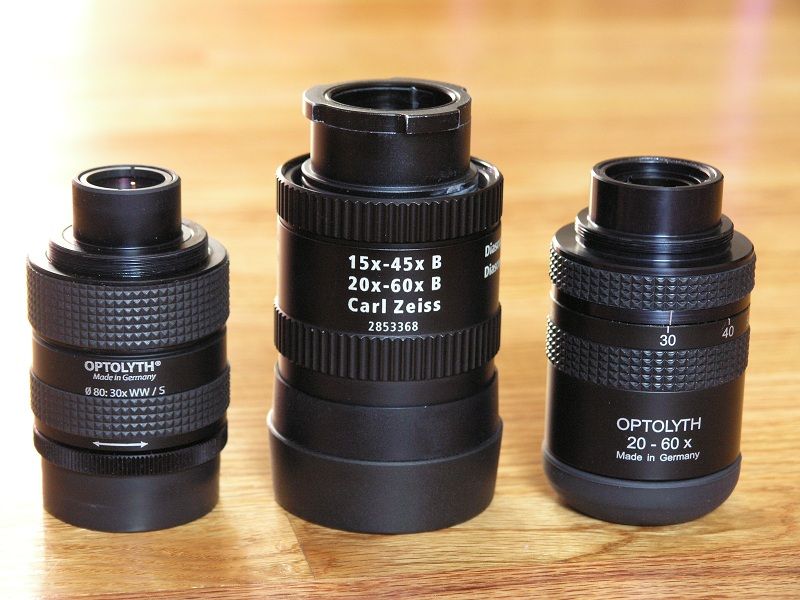
Optolyth S80 HD Compact with Eyepiece Cover threaded-on:

Optolyth S80 HD Compact Eyepiece. Note threads for Eyepiece Cover on the S80's Body:

Drawing of Optolyth MIL Ranging Reticle (Reticle not drawn to scale):
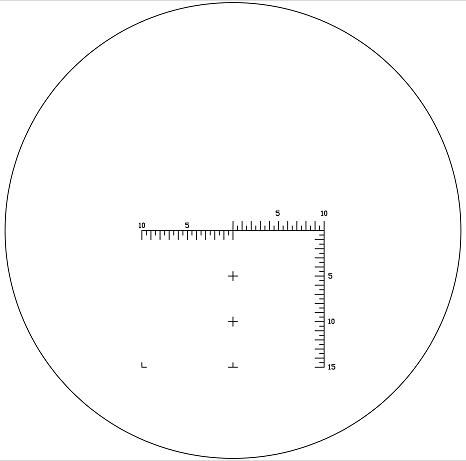
Gitzo GT1550T Traveller Tripod + Really Right Stuff BH-30 LR Compact Head and Optolyth S80 HD Compact
w/30X WA MIL Reticle Eyepiece. Here the scope is set-up to the Left of the shooter/spotter. The spotting
scope has been rotated to the Right within it's Collar, while the Eyepiece's Reticle has been rotated to the
Left to remain "square" with the target

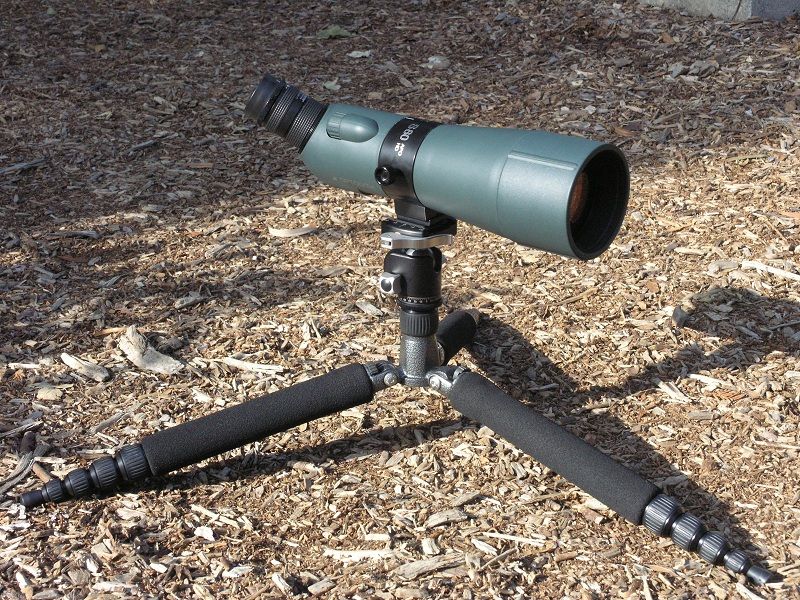
Keith
Several years ago I bought a Zeiss Diascope 65T FL spotting scope and a Zeiss Vario Eyepiece. I also planned to buy the Zeiss Fixed Eyepiece with the #43 Mildot reticle. Unfortunately for me, Zeiss Germany stopped exporting their Fixed Mildot Eyepiece and I couldn't find a dealer who had one in stock or could get one when I was ready to buy the Eyepiece. I spent close to four years looking for a Zeiss #43 Mildot Eyepiece to no avail.
Finally giving-up on ever being able to get one of the Zeiss #43 Mildot Eyepieces and knowing that obtaining the [Fixed] MIL reticle Eyepiece Zeiss produced for the Finnish Army was nothing more than a pipedream I started looking at other MIL reticle spotter options. I wanted a compact, lightweight spotting scope with superb image quality in a 45-degree angle body like my Diascope 65T FL. I also wanted as much eye relief as possible for use with glasses, so my options were rather limited.
After lots and lots of research I decided on the HD version of the Optolyth S80 Compact . Optolyth isn't as well known in the U.S. as Zeiss, Swarovski, Leica, Leupold, or Vortex, but their optics lineup and products are excellent. In the photographic world Optolyth lenses are considered to be right (at the top) with Zeiss. I bought the Optolyth 20-60X variable Eyepiece and a 30X Wide Angle Eyepiece with rotating MIL Hash reticle. The rotating reticle is really cool, as you can orient the reticle to be "square" regardless of the orientation of the Scope's Body within it's Rotating Collar.
Optolyth Compact Ergonomics:
Optolyth Compacts feature aluminum bodies with rubber-armor, Single Focus knobs, and 360-degree Rotating Collars. The G80 is a "Straight" model and the S80 is an "Angled" model. Both are available in both HD and non-HD versions. The HD versions use Fluorite glass.
The Bodies of the Optolyth Compacts are streamlined and taper gracefully from front to rear compared to the Zeiss Diascope 65T & 85T FL Bodies, whose Focus Knob "hump" and rear end are rather abrupt and bulky. Another nice touch is that the Optolyth Compacts have a threaded ring on the Body where the Eyepiece attaches. A hard plastic Dust Cover is supplied and can be threaded on to cover and protect the Eyepiece when not in use.
The rubber armor cushions the body from knocks and bumps, and the texture of Optolyth's rubber armor is similar to the texture of the rubber armor on the Swarovski spotters and the LG30 Laser Guide. The color is bluish compared the Swarovski Forest Green.
The Single Focus Knob glides smoothly throughout the adjustment range, and "dials-in" rapidly. After getting used to the Dual (Coarse and Fine Focus) Knobs of my (previous generation) Diascope 65T FL I found that I had to tweek the Focus very slowly for the most exacting focus. The newest generation Diascopes' have single focus knobs rather than the dual focusing knobs of previous Diascopes'.
S80 HD Compact Body:
The S80 Compact's Body is about .75" longer than the Body of the Diascope 65T FL, but because Zeiss Eyepieces are longer than Optolyth Eyepieces the S80 Compact actually winds-up being about the same OAL as a Diascope 65T FL and substantially shorter than a Diascope 85T FL once Eyepieces are attached their respective spotters. My S80 HD Compact equipped with the Optolyth 20-60X variable Eyepiece weighs just under 1 lb. more than my non-rubber armored 65T FL equipped with the Zeiss Vario 15-45X/20-60X Eyepiece.
Optolyth attaches the Eyepieces to the Body securely via standard threading rather than a bayonet attachment as on the Zeiss Diascopes'.
Optolyth Eyepieces:
The 30X Wide Angle MIL Reticle Eyepiece is fun to use, providing a wide FOV and razor-sharp, bright image behind it's MIL-based reticle. Optolyth offers a 30X WA for use on the 80mm Optolyths, and a 45X WA Eyepiece for use on the 100mm Optolyths. The reticle is placed in the lower half of the view and is designed to be used with the median leveled on the object under observation. The reticle has 10 MILs' of windage each direction and 15 MILs' of Elevation. There are 1 MIL tall hashes at each MIL and half-MIL tall hashes at each .5 MIL. In addition, there are "+" Elevation indicators every 5 MILs' from the center of the reticle's "aiming point".
The really cool thing (besides being a MIL Eyepiece) is that the reticle rotates within the Eyepiece so the reticle can be oriented perfectly regardless of the position of the Scope Body's orientation within the Rotating Ring, a big plus when the scope is offaxis from you and/or the scope Body is rotated either Right or Left). The ring that rotates the reticle is rubber-covered and is just forward of the Diopter Ring.
Also, Optolyth's MIL Reticle drawing isn't drawn to scale at all. The Reticle is actually much larger than depicted in the drawing - maybe 25% larger. As a result the SW and SE "corners" are much closer to the edge than shown in the Optolyth drawing. The number "15" of the Elevation Scale is especially close to the edge.
The Optolyth 30X WA Eyepieces have noticeably longer Eye Relief than the Zeiss Vario 15-45X/20-60X Eyepiece, which makes viewing very easy. The 30X WA Eyepieces' have fold-down Rubber Eyecups, and eyeglass wearers' will need to fold-down the Eyecup for best eye relief.
The 20-60X Eyepiece has extreme clarity at both low and high power. While the clarity isn't as quite as good at full (60X) as it is at lower power it is still very good. Anyone with any experience and understanding of optics knows that the clarity of all variable magnification optics declines as the magnification increases - it is just less so with higher end optics such as Zeiss, Swarovski, Leica, Optolyth, and the Kowa's flagship 88mm Prominar.
As with the Optolyth 30X WAs', the Optolyth 20-60X has noticeably longer Eye Relief than the Zeiss Vario 15-45X/20-60X Eyepiece, making viewing very easy. The Optolyth 20-60X and 30-60X Eyepieces' have Rubber Eyecups, and eyeglass wearers' will need to leave the Eyecups folded down for best eye relief.
S80 HD Compact Optical Performance:
OK, so the Optolyth S80 HD Compact is relatively compact and lightweight (its' kind of strange to say that since the S80 Compact weighs 4 lbs., 1.8 oz. with either the Variable or Fixed Eyepieces), but what about the optical quality? How does it compare to a Zeiss? Remember that my criteria were compact size, lightweight, superb image quality, generous eye relief, and 45-degree angle body.
I needed another tripod for a side-by side comparison so I headed down to my brother's house to borrow a second tripod. Mounting my Diascope 65T FL with it's Zeiss Vario 15-45X/20-60X Eyepiece on a Manfrotto 3221 alongside my new Optolyth S80 HD Compact with Optolyth 20-60X Eyepiece on top of my Gitzo 1550T my brother and I adjusted the Eyepieces of both scopes to apparent equivalent magnifications. We then looked at the leaves and branches of nearby elm and eucalyptus trees in sunlight and shadow.
My brother and I both noted that the view through the Zeiss 65T FL was noticeably brighter than the view through the Optolyth S80 HD Compact. This extra bright view gave the 65T FL a slight - and I mean very slight, edge when peering into the shadows and in overall clarity and the ability to discern detail. The downside is that the 65T's "brightness" tends to give the image a somewhat "washed-out" look compared to the Optolyth S80 HD Compact and a Swarovski. Anyone who has looked through a Diascope alongside a Swarovski HD knows what I'm talking about.
The S80 HD Compact has markedly better color rendition - the colors are more life-like without being over-saturated. The color and contrast are so good and the view is so sharp that the image looks 3D. Its' that good. Still, while the image is razor-sharp and has excellent depth-of-field, I still have to give a slight - and I mean very slight , edge to the Diascope 65T FL for overall clarity. I attribute this to Zeiss' lens coatings, which are arguably the best in the optics world.
In low light performance, the S80 HD Compact was definitely superior. I was able to discern individual trees and bushes in the dark more easily with the S80 HD Compact than with my 65T FL. However, in my opinion (and to my 47 year-old eyes), the difference is not overwhelming. This is despite the S80 HD Compact's 15mm Objective Lens diameter advantage over the 65T FL. Chock it up to superior lens coatings' or better execution of optical design, the 65T FL held it's own against the S80 HD Compact more than an hour after sunset and in the pre-dawn hours of morning. The S80 Compact's 15mm Objective advantage only becomes more pronounced in very low light.
So, (to my brother and I) the 65T FL holds a slight edge in daylight optical performance over the larger, heavier S80 HD Compact, while the tables are turned after dark. Is it worth carrying around an extra pound of scope in your pack just for the slightly better low light performance? Not to me.
If your main criteria is image quality and you don't care about a MIL reticle I would probably choose a Zeiss Diascope 65T FL or the bigger Zeiss Diascope 85T FL as they are probably going to provide brighter images than the current Optolyth HD Compacts'. However, as the Zeiss Mildot Eyepieces are harder to find than hen's teeth these days, if you want a MIL reticle Eyepiece the Optolyth S80 HD is the better bet as the optical performance is very close to the Zeiss 65T FL and a 30X MIL Eyepiece is readily available. And once you've used it, you realize that the rotating reticle of the Optolyth MIL Eyepiece is a must-have feature on an Eyepiece that is used on a spotting scope with a rotating collar.
When the 30X Wide Angle Fixed Eyepiece is attached, or when the 20-60X Eyepiece is attached and turned-down to "low" magnification (<30X), there is a very faint grayish halo around the outer edge of the view. I'm not sure what it is, but its' as if the gray anodized barrel (which extends more than an inch forward of the Objective Lens) is just within the "corner" of the extreme edges of the view. It doesn't seem to be vignetting, as the image at the edge is still bright, colorful, and sharp. You have to look for it. Not a deal-breaker, but I know its' there.
Also, my S80 HD Compact has a slight yellowish cast to the image. Naturally-occurring Fluorite crystals come in all colors of the spectrum (the colors are caused by impurities in the crystal). Therefore, color casts are "normal" with Fluorite glass. However, Pure Fluorite, such as is used in the Kowa Prominar 883 and 884 is colorless. This is probably one of the primary factors in the 88mm Prominar's wonderful resolution and color fidelity.
I really like my new Optolyth S80 HD Compact, but have four (4) gripes about it:
(1) See "NOTES": above. While a bit annoying I don't "focus" on it, and I don't regret buying my S80 HD Compact or selling my Diascope 65T FL. Like most scopes, the 65T FL had a slight loss of "flatness" and clarity at the extreme edge of the view. I didn't sell my 65T FL until I had evaluated the two scopes side-by-side, and based on that comparision I highly recommend the S80 HD Compact - especially if you want the option of a MIL-based Eyepiece. And remember, only Optolyth offers a MIL Reticle Eyepiece that rotates to keep the reticle square to the horizon.
(2) The barrel isn't threaded to accept a filter. This prevents me from using a Hoya SMC UV Haze Filter to protect the Objective lens. Nothing I can do about this so I have to drive-on.
(3) The Pivot Tension Knob on the Rotating Collar is rather tall, and it's shaft is too long. As a result the Pivot Tension Knob sticks-out conspicuously, ready to snag on anything that gets too close. If I can't easily find a lower profile knob to replace the factory knob I'll probably just shorten the shaft on the factory knob so it doesn't stick-out so damn far.
(4) Both of my Eyepieces were missing one protective cap each as they came from the factory. The 20-60X Eyepiece was missing the cap that fits over the Ocular end, and the 30X Wide Angle MIL Reticle Eyepiece was missing the protective cap that fits over the Objective end. The factory may have figured that the Eyepiece will be threaded into the Body and the Eyepiece Cover will be used to protect the Eyepiece when the scope isn't in use, but what if the Eyepiece(s) aren't on the Body or you have multiple Eyepieces?
Great scope and eyepieces, but Optolyth shorts you on a couple of .02 cent caps that protect the lenses of $500.00 Eyepieces. WTF? I measured the O.D.s' of both ends of both Eyepieces and will be buying some quality push-on lens caps to protect the Eyepiece lenses when off the Body. Annoying, as good German-made lens caps run $10.00 or more depending on the size.
I've contacted a couple of Hide Vendors and plan on having one of them sew me a padded, custom SOC (Stay-On-Case) and couple of padded Eyepiece Cases so they don't get bashed around too much in my drag bag or other packs. The availability and production schedule of those Vendors is key in who will be my choice.
Zeiss Diascope 65T FL Body (left) compared to Optolyth S80 HD Compact Body (right):

Zeiss Diascope 65T FL & Zeiss Vario 15-45X/20-60X Eyepiece (left) compared to Optolyth S80 HD Compact & Optolyth 20-60X Eyepiece (right):

Zeiss Diascope 65T FL & Zeiss Vario 15-45X/20-60X Eyepiece (back) compared to Optolyth S80 HD Compact & Optolyth 20-60X Eyepiece (front):

Zeiss Diascope 65T FL & Zeiss Vario 15-45X/20-60X Eyepiece (top) compared to Optolyth S80 HD Compact & Optolyth 20-60X Eyepiece (bottom):

Optolyth 30X Wide Angle (Left), Zeiss Vario Zoom Eyepiece (Center), and Optolyth 20-60X Zoom Eyepiece (Right):

Optolyth S80 HD Compact with Eyepiece Cover threaded-on:

Optolyth S80 HD Compact Eyepiece. Note threads for Eyepiece Cover on the S80's Body:

Drawing of Optolyth MIL Ranging Reticle (Reticle not drawn to scale):

Gitzo GT1550T Traveller Tripod + Really Right Stuff BH-30 LR Compact Head and Optolyth S80 HD Compact
w/30X WA MIL Reticle Eyepiece. Here the scope is set-up to the Left of the shooter/spotter. The spotting
scope has been rotated to the Right within it's Collar, while the Eyepiece's Reticle has been rotated to the
Left to remain "square" with the target


Keith
Last edited:

